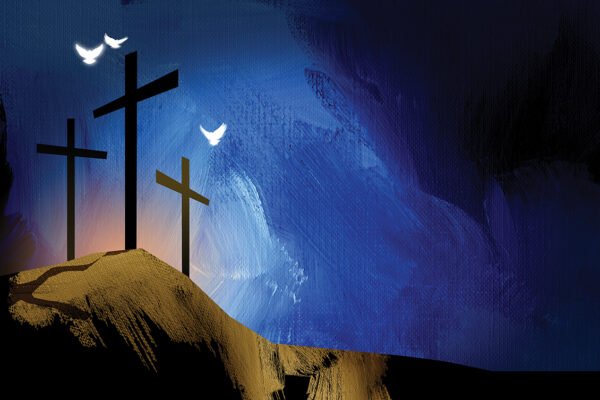A balanced look at the atonement.
by Dr. David R. Downey
All history points to Jesus’ work among us. It was appropriate that time-dating used to go according to bc and ad (before Christ and anno Domini, or “in the year of the Lord”). Though often criticized by some, for us, history still pivots on the appearance, life, and work of Jesus Christ.
Additionally, if we were to list the events of His earthly life in significant order, the Resurrection and Ascension would have to be the pinnacle. Jesus’ resurrection is the beginning of our hope in life. This hope is offered to all who trust in Him, even in ages to come and to all who called Him friend (James 2:23).
However, to interpret the Resurrection faithfully, we should never lose sight of the Cross. As a pastor, I tried to include the message of the triumphal entry before I spoke of the Resurrection. This was simply to emphasize that Jesus approached the joy of the Resurrection riding humbly on a donkey, receiving the praises of folks who would soon abandon Him to the cross.
Certainly, the message of the Cross and the Resurrection bring us great joy. Earthly time and spiritual time coalesced in these great events. The power and significance of their meaning takes our breath away. But the backbeat of this story is that it is set in a broken world in need of redemption. While contemplating Jesus’ sacrifice, we must hear the bass tones of cruelty in a world that would sacrifice a perfect man.
Loss of life
God wants to give us a deeper meaning. He wants to tell us what we must remember when contemplating the gift of His Son. Two thoughts come to mind. The first is this: You cannot experience resurrection without first experiencing loss of life.
It seems obvious that you would have to lose life to regain it. But in a spiritual context, we might miss this.
Years ago, an assignment in a preaching class required that I explain the “Servant passage” (Isaiah 52:13—53:12) by using exegesis. This means using language, background, and biblical resources carefully to interpret the meaning — or, as we seminarians interpreted it, to study until your eyes fall out.
I dreaded the assignment at first glance, but then came to appreciate it as I peered into the text. Some of the words in this wonderful messianic prophecy are, to use an A. T. Robertson phrase, like clods of earth falling on a coffin:
His appearance was marred more than any man . . . like a tender shoot . . . out of parched ground . . . He was despised and forsaken of men, a man of sorrows . . . our sorrows He carried . . . He was pierced through for our transgressions . . . Like a lamb that is led to slaughter, . . . He did not open His mouth . . . the Lord was pleased to crush Him, putting Him to grief” (52:14; 53:2-5, 7, 10).
It helps to remember that ten days of repentance preceded the great Day of Atonement (Yom Kippur). This clearly revealed to the Jews the need to repent before celebrating the atonement. The Day of Atonement itself was the most sacred of the feast days and the only one that required fasting. On that solemn day, shedding blood was necessary, and symbolically released the sins of the people into the wilderness through the scapegoat. Jesus fulfilled this prophecy and showed us that the hard work of a sinless life, culminating in a sacrificial death, brings us the hope we celebrate today.
We display our victory by following the Master. Like Him, we have lost our life to gain it. We should not follow Jesus only occasionally but all the time. He gave us, through His sacrifice, the great joy of atonement: Since we have received such a great gift of eternal life, we ae compelled to gladly give all of ourselves all the time.
Empty tomb
The second thought about the gift of God’s Son is this: Alone, the cross would just be a sad human event, but an empty tomb remains today.
The Lord of life submitting to death is a tremendous message, but His resurrection is foundational to our joy and worship all year long. He is no longer in the tomb!
Many great leaders, spiritual and political, have a shrine where they rest in state. Why did no one preserve the place of Jesus’ burial and turn it into a shrine? We are not certain where this tomb is today because no one thought to mark it.
Jesus is not there; He only visited a short while. In the tumult and victory of the Resurrection, who could think of a tomb?
The day of Jesus’ resurrection stands as the greatest day ever recorded. In her song “Was It a Morning Like This,” Sandi Patty describes that great day and the earth resounding in praise that He had risen. Isaiah prophesied this victory in the aforementioned Servant passage:
“Behold, My servant will prosper . . . surely our griefs He Himself bore, . . . by His scourging we are healed. . . . My Servant, will justify the many, . . . Therefore, I will allot Him a portion with the great” (52:13; 53:4, 5, 11, 12).
It is no simple “feel good” message we share. We are not trying to pump ourselves up, as some would suggest. We are responding to the historical event of the Resurrection: Jesus ascended and sat at the right hand of the Father in heaven, and He has promised to share His victory with those who will accept Him!
Action Steps
If you have asked Jesus to be the Lord of your life, then consider an appropriate response. Following are a few suggestions for action, each followed by a verse for meditation.
• Understand that your new life includes the cross. “And he who does not take his cross and follow after Me is not worthy of Me” (Matthew 10:38).
• Look up! (After all, He ascended.) “Straighten up and lift up your heads, because your redemption is drawing near” (Luke 21:28).
• Walk, realizing that what began in grace continues in grace. “Therefore, having been justified by faith, we have peace with God through our Lord Jesus Christ, through whom also we have obtained our introduction by faith into this grace in which we stand; and we exult in hope of the glory of God” (Romans 5:1, 2).
• Share your joy! “Sanctify Christ as Lord in your hearts, always being ready to make a defense to everyone who asks you to give an account for the hope that is in you, yet with gentleness and reverence” (1 Peter 3:15).
— Dr. David Downey







